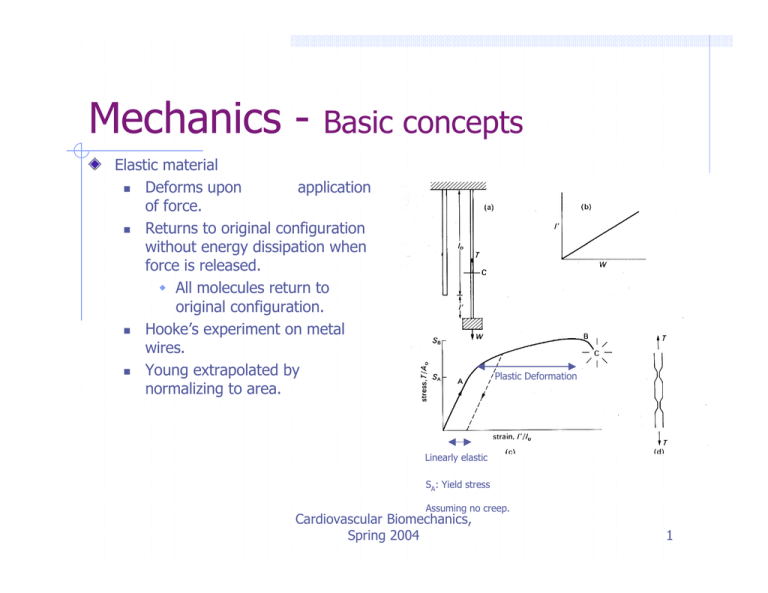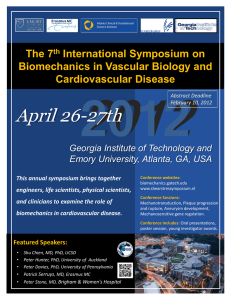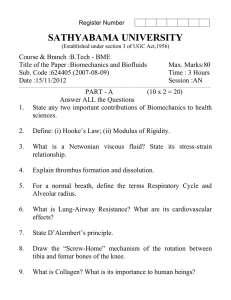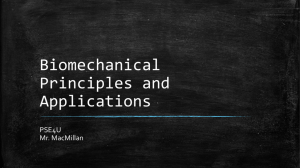lecture3
advertisement

Mechanics - Basic concepts Elastic material n Deforms upon application of force. n Returns to original configuration without energy dissipation when force is released. w All molecules return to original configuration. n Hooke’s experiment on metal wires. n Young extrapolated by normalizing to area. Plastic Deformation Linearly elastic SA: Yield stress Assuming no creep. Cardiovascular Biomechanics, Spring 2004 1 Mechanics - Basic concepts Linearly elastic behavior follows Hooke’s law. n n Stress (Force/Area) linearly proportional to strain (deformation (non-dimensional)). Assumptions of: w No creep. n Increase in strain over longer periods of time (slow flow). w No stress relaxation. n Fall in initial stress value over longer periods of time. w No plastic deformation. n Change in molecular structure. Solid -vs- fluid: ability to withstand stress. Viscoelastic material: elastic solid material that exhibits flow properties (creep, stress relaxation). Cardiovascular Biomechanics, Spring 2004 2 Young’s Modulus & Poisson’s Ratio Within linear range of behavior: T = E l' A l o o Proportionality constant is Young’s Modulus (E: N/m2). Stretching causes contraction in cross-sectional area. a' = -s l' Circular cylinder: a l s: Poisson’s ratio o n =0.5 for incompressible material. o w No volume change. Arterial walls can be assumed incompressible. Cardiovascular Biomechanics, Spring 2004 3 Other components of stress Tension/compression in longitudinal direction has been considered. Other stresses can be present. Shearing Stress Bending Stress Cardiovascular Biomechanics, Spring 2004 Torsional Stress 4 Properties of Blood Vessel Walls Homogenous and isotropic assumptions. n E, s do not vary within the material. Independent of direction in which stress is applied. Is this true of blood vessel walls ? n n n n ~70% of walls consists of water (incompressible & inelastic). Rest of material: elastic fibers. Three types of fibers: w Collagen w Elastin w Smooth muscle. Cardiovascular Biomechanics, Spring 2004 5 Properties of Blood Vessel Walls Elastin Collagen Cardiovascular Biomechanics, Spring 2004 6 Properties of Blood Vessel Walls Non-linear behavior. n Measure effective Young’s modulus (Eeff) by measuring local slope. Peak Eeff for: n n n Elastin: 3 X 105 N/m2. Collagen: ~108. Smooth muscle: ~105-106 (??) - active structure. Proportion of fibers varies depending on type of artery or vein. Cardiovascular Biomechanics, Spring 2004 7 Blood vessel walls Endothelium: Single cell layer separating wall and blood Elastic tissue: Elastin Fibrous tissue: Collagen Cardiovascular Biomechanics, Spring 2004 8 Measurement of Eeff Cardiovascular Biomechanics, Spring 2004 9 Changes in stress-strain characteristics with time 3 consecutive pressurevolume curves for a femoral artery Note hysteresis. Cardiovascular Biomechanics, Spring 2004 10 Viscoelastic behavior Purely elastic material: n No phase lag between strain and stress. Viscoelastic material: n n Strain lags stress. Possible to represent major features of viscoelastic behavior via a Dynamic Young’s modulus (Edyn) and effective viscosity (h) Cardiovascular Biomechanics, Spring 2004 11 Statics of an elastic tube Use force balance to examine relationship between radius, pressure and wall tension. Result: pi ri - pe re = Sq h Sq: Hoop stress Cardiovascular Biomechanics, Spring 2004 12





